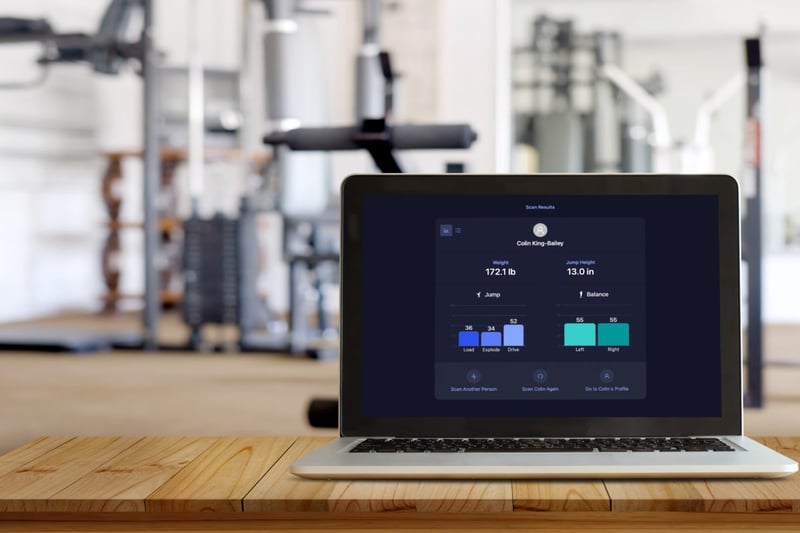
With the resurgence of force plates in recent years, their use and the data they provide are more accessible than ever before due to the commoditization of the hardware. What used to cost tens of thousands of dollars can now be manufactured and sold for a few hundred.
There are absolutely different levels of force plate quality and accuracy; however, the one thing all force plates have in common is that they measure forces in newtons. From there, the storage, reliability, visualization, and suggested action to be taken is dependent on the accompanying software and its infrastructure.
For the sake of this post, we will reference the force plate data that is available based on our Movement Health Platform (MHP). Keep in mind that Sparta Science provides a fully comprehensive data platform and machine-learning ecosystem for all types of human observation data. Whether utilizing our Sparta Scan Kit or other force plate hardware, there are generally four levels of force plate data available: Data-Driven Metrics, Normalized Metrics, Calculated/Raw Metrics, and Time-Series Data. The purpose of this is not self-promotion but rather a disclaimer of our approach since not all force plate software providers collect, store, and analyze force plate data the same.
First, movement data is taken from its source (time-series data, force measured over time) and standardized with built-in error detection and reliability software automation. The Sparta Scan Kit is the only solution that provides this objective filtering as standard, which means the data and insights can be trusted and scaled.
From there, our data platform can make available reliably captured data AND the ability to leverage the machine learning (ML) and artificial intelligence (AI) capabilities of our Calculation Engine. The four types of data and their utility and accessibility can be seen in the table below.
| DATA TYPE | DESCRIPTION | UTILITY | STORAGE & ACCESS |
| Data-Driven Metrics | Derived metrics utilizing advanced analytics optimized for reliability and utility | Actionable ML-derived metrics for performance, risk, triage, and other relevant outcomes to assist in decision-making. | Actionable for real-time viewing in offline/online environments. Can be exported via Management Console and integrated via API. |
| Normalized Metrics | Calculated metrics normalized to relevant cohorts or populations utilizing T-scores or Percentiles | Calculated metrics contextualized by comparing against a global database and specific cohorts. Enables ranking, baselining, comparisons, and threshold development interpretation and actionability. | Available for real-time viewing in offline/online environments. Can be exported via Management Console and integrated via API. |
| Calculated (Raw) Metrics | Metrics derived from time-series data based on principles of physics, posturography, or signal analysis in relevant units | Calculated from time-series data to explain or summarize different components (e.g., size, direction, complexity, duration) of force plate data signals. Typically utilized in research settings. | Available for real-time viewing in offline/online environments. Can be exported via Management Console and integrated via API. |
| Time-Series Data | Raw time-series data of an absolute measure of force (N) every millisecond (1000 Hz) | Can be utilized to calculate any metric from force plate data capture. Typically only utilized in research settings, this data is often discarded. | Available for real-time access in online environments. Can be exported via Management Console and integrated via API. |
Data For Action, Now
First and foremost, Sparta Science is driven by providing the most reliable, valid, and actionable metrics that facilitate real-time decision-making in operational settings. This is where the Data-Driven and Normalized Metrics are best placed to provide instant value and engagement because they can easily be interpreted and actioned. An example is that an individual can understand their movement vulnerabilities and efficiency compared to their peers via their Risk and Sparta Scores. At the same time, this information can be shared with multiple clinical and management stakeholders for aligned awareness and decision-making.
While real-time actionability should always be the end goal, the option to interact with data for a range of research, education, and customized problem-solving needs can also be an important capability. This is where the Time-Series and Raw Data are valuable. What should be noted, however, is that these types of data generally require researchers and applied scientists to interpret, analyze, and communicate meaning. While important for learning and innovation, this data is less actionable and engaging to all stakeholders and can oftentimes be a distraction to practitioners needing to make real-time decisions. An example could be exporting a large, longitudinal dataset and sharing this with a research and development partner to analyze and explore a range of bespoke questions. This level of data is extremely valuable in "analyze" phases, and the time-series data should always be stored to ensure reliability and the future value of the data (called data provenance), but is much less critical for real-time operations.